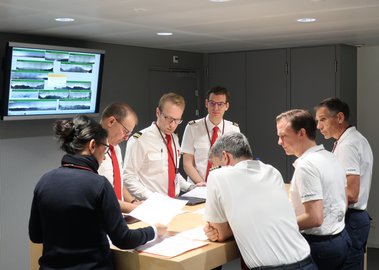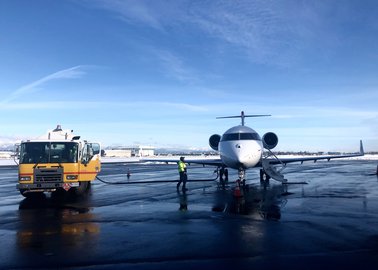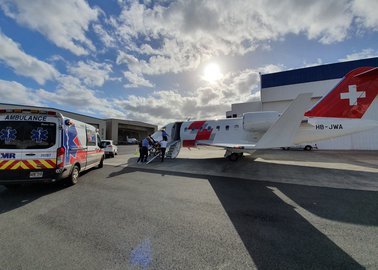It happens while crossing a road in Honolulu that branches off from a dual carriageway: Aaron is already in the middle of the pedestrian crossing when a car suddenly turns off the dual carriageway and hits him from the side. Right in front of his girlfriend’s eyes, the 28-year-old man from Zug is first thrown onto the bonnet of the car and then against the windscreen, before landing with full force on the kerb of the pavement. The staff at the nearby hotel react quickly and call out the emergency services, who arrive at the scene of the accident shortly afterwards and take the young man to hospital.
Anything can happen anywhere at any time
His girlfriend, Janine, still vividly remembers the anxious days and weeks afterwards: “Aaron suffered a sevenfold fracture of the skull with brain haemorrhages, three fractures of the cervical vertebrae and a ruptured liver in the accident,” she says. While her boyfriend is in an artificial coma, Janine stays by his bedside and watches over him around the clock. She looks after him, talks with the doctors and nursing staff, and keeps both their families up to date. Just a few hours after the accident, she contacts Rega. “As Rega patrons, we knew that Rega also flies patients from countries abroad back home to Switzerland,” she says. They had always been very aware that something could go wrong at any time during activities like freeskiing or hiking. “But we never thought that we would have to request Rega’s assistance after crossing a pedestrian crossing in Honolulu.”
Flying intensive care units
No matter where in the world someone needs Rega’s help: with its three long-range ambulance jets, Rega crews can fly seriously injured or ill patients back to Switzerland from even the most remote corners of our planet. Before a Rega jet takes off on a mission, however, Rega’s medical consultants need to carry out a thorough medical assessment of the case. From the Operations Centre far away, they get an as accurate a picture as possible of a patient’s state of health and medical care on location and assess, among other things, whether they are fit to be transported in the first place.
Medical clarifications
Shortly after Janine's first call, Rega medical consultant Gabriela Staub contacts the doctor-in-attendance at the hospital in Honolulu. She obtains detailed information about Aaron’s injuries and the situation on location in order to assess whether or not repatriation is both possible and sensible. Due to his severe head and brain injuries, however, Aaron is not yet fit for transport. From now on, the team of Rega medical consultants are in daily contact with Janine and the local doctors. In this way, they are able to judge when Aaron’s medical condition is stable enough to transport him to the airport and endure the long flight in the Rega jet back home to Switzerland.
Complex mission planning
After two weeks in the intensive care unit in Honolulu, it appears that Aaron’s medical condition will allow him to be repatriated soon. Now, on the other side of the world, preparations for the long mission are set under way at the Rega Operations Centre at Zurich Airport. The Jet Operations Centre organises the entire mission in advance. To do this, flight coordinator jet Sabine Zahn draws up a detailed time schedule. With ultra long-haul flights, these preparations are particularly complex and extensive: “For missions to far-off countries, we also have to meticulously plan stopovers for the ambulance jet to be refuelled.” For this, the opening hours of the respective airport need to be taken into account, landing permits obtained and arrangements made with the handling service providers, to ensure that the stopover is as short as possible. For the flight to Hawaii, the flight coordinator schedules two stopovers in Newfoundland and Vancouver (Canada) in consultation with the dispatcher, who is responsible for the flight planning and route. The mission is already fully organised and ready to go when something comes up: “The weather had suddenly changed, so we had to move the first refuelling stop in Canada at short notice from Gander to Goose Bay, which lies around 600 kilometres to the north,” the flight coordinator explains. “This is typical of our everyday work at the Operations Centre; we always have to remain flexible and also be able to react quickly to the unexpected,” says Sabine Zahn. “This is challenging, but it makes our job particularly interesting.”
A special birthday present
The Rega medical crew finally arrive at the hospital in Honolulu on Aaron’s 29th birthday. Janine smiles when she thinks back to that moment: “He could hardly wait for them to come, but he was still rather confused and wanted to pack his suitcase days before.” Flight physician Florian Mayer recalls: “Medically, he was in a relatively good condition and he was also responsive. At the same time, however, he was rather confused, which is very common in patients with traumatic brain injury.” Nevertheless, the beginning of the return journey home is Aaron’s first conscious memory since the accident. “I remember being pushed on a stretcher trolley into the jet. And for some reason, I recall that there was also a coffee machine on board,” he says with a laugh. The subsequent flight back to Zurich goes smoothly. “Because of the life-threatening injuries Aaron had suffered, we had to monitor him constantly,” explains the Rega flight physician. Sharing the duties efficiently between him and the intensive care nurse was extremely important, especially on such long missions, so that they could both have a short rest between caring for the patient and looking after the relatives, he says. Janine, on the other hand, can finally, after three weeks, breathe a little easier: “Knowing that Aaron was in good hands, I was able to sleep properly and deeply for the first time in the Rega jet.” In the meantime, apart from a few limitations, Aaron can lead a normal life again. A good year after his accident, he is about to return to working life.



